Explore quaint villages, medieval castles, ancient places and spectacular coastlines with our epic 2 week, self-drive south west England road trip itinerary. Starting and finishing in London, this is a looping drive to Cornwall and back via the beautiful counties of Surrey, Hampshire, Dorset, Devon, Somerset and Wiltshire.
England, with its beautiful rolling landscapes and winding country lanes, is made for road tripping. But where to even start?
We’ve been pulling out the old AA road map and exploring English laneways for years now, and we still find the sheer diversity of towns and villages, landscapes, historical sites (and old pubs!) makes putting together any kind of England road trip itinerary a special kind of torture. We just want to see and do everything.
The south west of England is a case in point. It is quite literally packed with the kinds of destinations and experiences that make for an unforgettable road trip.
Quaint medieval villages? Too many to count. Ancient sites? The highest concentration in western Europe. World Heritage? All kinds, from ancient mines, neolithic standing stones and two-thousand-year-old Roman baths, to a stunning coastline with a unique geological and fossil story.
You’ll also find sweeping coastal landscapes and moors scattered with granite tors and traces of structures built by ancient people in a distant past. Moody castles and abbey ruins that whisper of bygone heydays. And of course, a virtually endless choice of cosy old pubs where you can nurse a pint of ale under the low rafters and imagine what the walls would say if they could talk.
What it all adds up to is a looping road trip from London to Cornwall and back that’s something of a tour de force.
This itinerary packs a lot in, but it’s designed as an introduction to this wonderful corner of the country. It takes on board our own learnings and experiences, and has evolved as we’ve visited and revisited these areas. Ultimately, this itinerary showcases what we reckon are some of the very best places to visit in south west England.
Our itinerary takes two weeks, but you could certainly make it longer and slower by giving more days to any of the places it includes.
If you have only one week, we would suggest leaving the Cornwall road trip component of this itinerary for next time. Or do the opposite and focus all your time there instead – it’s a magical place.
Read on for our day-by-day, self-drive south west England itinerary, and our top take-outs and tips for a road trip you won’t soon forget.
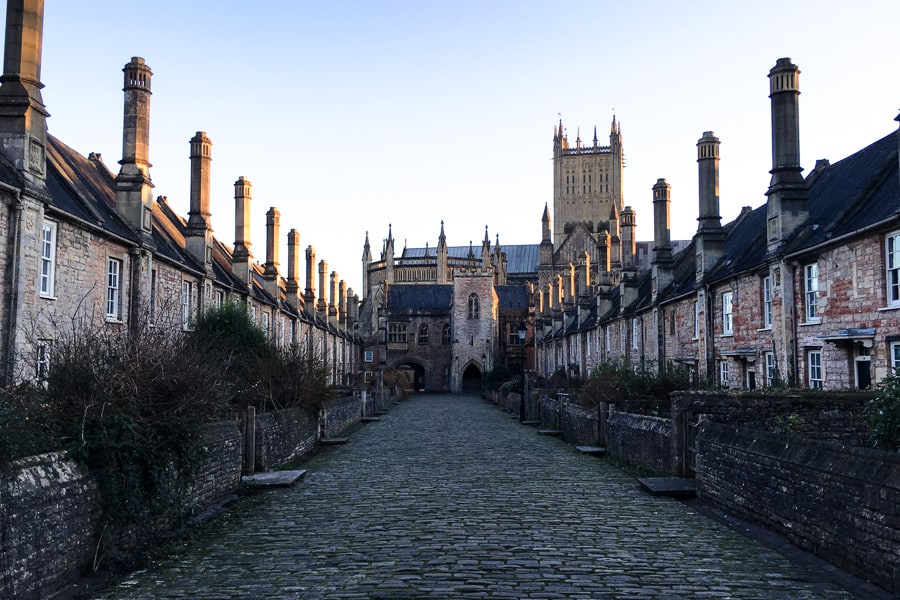
South West England Road Trip Itinerary Snapshot
Start & Finish: London Heathrow, United Kingdom
Distance: At minimum, around 1,350km (840 miles)
How long do I need? This is a jam-packed 2 week looping road trip from London Heathrow, travelling to Cornwall and back via the English counties of Hampshire, Dorset, Devon, Cornwall, Somerset and Wiltshire.
Overnight stops: 1 night in Winchester, 1 night in Lyme Regis, 1 night in Dartmouth, 2 nights in Porthleven, 2 nights on the Penwith peninsula (eg. Penzance or St Ives), 1 night in Padstow, 1 night in Tintagel, 1 night in Exeter, 1 night in Wells and 2 nights in Bath.
What’s in this post?
What’s the route?
Day 1 – London to Winchester
Day 2 – Winchester to Lyme Regis along the Jurassic Coast
Day 3 – Lyme Regis to Dartmouth via Exeter
Day 4 – Dartmouth to Porthleven via Polperro
Day 5 – Lizard Peninsula, Cornwall
Day 6 – Penwith Peninsula, Cornwall
Day 7 – Penwith Peninsula, Cornwall
Day 8 – St Ives to Padstow, Cornwall
Day 9 – Port Isaac & Tintagel, Cornwall
Day 10 – St Nectan’s Glen, Boscastle & Bodmin Moor, Cornwall
Day 11 – Wells & Glastonbury
Day 12 – Bath
Day 13 – Castle Combe, Lacock Abbey & Bath
Day 14 – Bath to London via Stonehenge
Planning a South West of England Road Trip
Getting to London
Best time to visit south west England
Where to stay in the south west
Driving and renting a car in England
This post contains affiliate links. If you choose to buy through these links we may earn a small commission at no extra cost to you, which helps us to keep Two for the World running. Many thanks for your support!
What’s the route?
Our starting point for this south west England road trip itinerary is London Heathrow Airport, which is to the west of central London.
This is a convenient launchpad as there are extensive car hire options at Heathrow and it’s close to the M25 motorway, which is the first major road we’ll be taking as we head into the south west of England.
You could also start this road trip at Gatwick Airport to the south of London. There are plenty of car hire options here too.
You’ll need a car for this itinerary, so unless you plan to drive your own car, you’ll need to rent one. We use Rentalcars.com and Discover Cars to search for and hire cars and we suggest checking prices on both to find the best deal you can.
Over two weeks, you’ll make a looping road trip from London through the counties of Hampshire, Dorset, Devon, Cornwall, Somerset and Wiltshire.
You’ll drive through picturesque country lanes visiting castles, abbeys and cathedrals, medieval villages, neolithic and Bronze Age sites, ancient places, World Heritage sites, all while immersing in spectacular coastal and countryside scenery.
There’s a huge amount to see throughout this journey. We’ve cherrypicked what we feel are among the best sites and scenery in each region, to give you a feel for these places and the wonderful diversity of landscapes, history and culture of south west England.
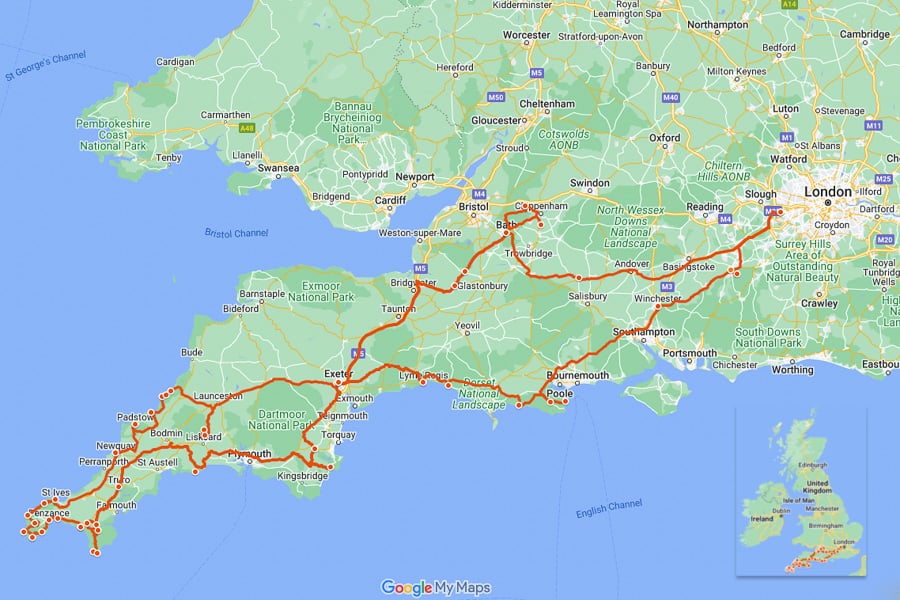
This road trip through the south west of England is one of the entries on our Bucket List of 100 Ultimate Road Trips Around the World. Check out what else is on the list here.
Our 2 Week South West England Road Trip Itinerary
Day 1 – London Heathrow to Winchester
Highlights: Farnham Castle | Waverley Abbey | Winchester historic centre
Total driving distance: appx. 100km (62 miles) assuming a Heathrow starting point
Total driving time: appx. 1.5 hours
Overnight: Winchester
Let’s hit the road! There are two historic stops on this first morning of our south west England road trip, as you travel from London to the ancient city of Winchester.
Once you’ve collected your hire car, set your GPS for today’s first stop, Farnham Castle.
If you’re coming from London Heathrow, you’ll head south on the M25 (the London orbital road) to the M3, where you’ll head west. If you’re coming from London Gatwick, take the M25 north west to the A3 and then head west.
If you’re travelling from somewhere else, make Farnham Castle your starting point.
Farnham Castle
Our first stop is Farnham Castle, an impressive motte and ‘shell keep’ ruin attached to a beautifully preserved medieval house in Surrey.
It usually opens from 9am on weekdays and 10am on weekends, but check ahead before you visit as this can vary. Time your arrival for opening, or head into the charming little village for a coffee first.
Farnham Castle was home to Winchester’s bishops in the 12th and 13th centuries, and it’s been occupied almost ever since.
If you’re lucky, you’ll have the ruins and their wonderful views all to yourself as we did. Even the ghostly presence rumoured to hang around the old stones had better things to do on the day we visited.
Waverley Abbey
Just 10 minutes down the road, and well worth the detour, are the wonderfully evocative ruins of Waverley Abbey.
The site is free and open during daylight hours. Park at the abbey carpark and head through the nearby field for around 5 minutes to the ruins.
Spread out over the field next to the pretty River Wey, this ambient site was home to the first Cistercian monastery in Britain, founded in the early 12th century. Today you’ll see the fine stone remains of a vaulted refectory and surrounding buildings.
Keep an eye out also for the famous Waverley Yew, a vast tree that’s been standing sentinel here for around 500 years.
Travel tip: We recommend bringing decent and durable outdoor shoes for this road trip. They’ll come in handy almost immediately for this walk across the field to the abbey ruins, especially if it’s been raining.
While we were delighted by this site, we were less so with the state of our shoes afterwards. It was a sentiment that carried through our entire trip, but muddy shoes is usually par for course when exploring the great outdoors in England.

Winchester
From the abbey, it’s an easy 45-minute drive to Winchester. This important cathedral city was established as King Alfred the Great’s ancient capital of Wessex in the 9th century, and it remained England’s premier town until the Normans arrived in 1066.
The history here goes back thousands of years, and the city is imbued with a sense of this long and varied past.
If you’re craving lunch by this stage, park up in one of the city’s paid public carparks (we generally use Google maps to search for car parks) and either pick up something to go on the high street, or head to our favourite spot, The Bishop on the Bridge pub, for lunch on the terrace by the river. You’ll find the city’s large statue of Alfred the Great just nearby.
After lunch, set off on an afternoon meander around the main sites and highlights of the old town. You can go self-guided as we did with this downloadable City Walk.
If you’d like to discover the city with a real guide, this 2-hour guided tour departs daily at 10am. You’d just need to head straight to Winchester this morning to be there in time.
Or tonight, for something quirky and different, why not get out with a guide for a tour of the city’s darker side on this ghost walk.
Highlights of Winchester include the awe-inspiring Winchester Cathedral (it has a charming little Christmas market that we recommend visiting if you’re around in December), the impressive ruins of Wolvesey Castle, and the medieval Great Hall with its Arthurian-inspired round table hanging on the wall.

Travel tip: There’s plenty to do and see in Winchester, and while our itinerary spends just an afternoon and evening here, you might consider staying longer and exploring more. Or return another time – Winchester is a great short road trip from London.
Where to stay in Winchester
You have plenty of options across the board in and around Winchester, from budget chain hotels on the city outskirts to charming pub stays right in the historic centre.
We stayed at the lovely Bugle Inn at Twyford, 10 minutes’ drive from Winchester. The breakfast was great and there was parking on site.
The following centrally located stays also get great reviews, though check the parking situation with the accommodation provider.
- Good value: The Westgate – modern rooms in historic pub | clean and quiet | close to historic centre
- Mid-range: The Old Vine – characterful rooms | great breakfast | central location
- Spend a bit more: Hotel du Vin Winchester – brightly decorated | comfortable rooms | Well located
Day 2 – Winchester to Lyme Regis along the Jurassic Coast
Highlights: Old Harry Rocks | Corfe Castle | Durdle Door | West Bay | Lyme Regis
Total driving distance: appx. 200km (125 miles)
Total driving time: appx. 3.5 to 4 hours
Overnight: Lyme Regis
On Day 2 of our south west UK road trip itinerary, you’ll be exploring some of the highlights of England’s spectacular Jurassic Coast.
Named for the extraordinary geological record packed into its landscape, rock layers and fossils, the natural history captured within this 150km (95 mile) stretch of coast spans 185 million years.
The Jurassic Coast is so geologically important, it’s been listed as World Heritage. It sweeps westward from Old Harry Rocks near Swanage in Dorset, to Orcombe Point in Exmouth, Devon.
Aim to start early as our itinerary packs a lot in today. If you want to slow the pace or spend more time in some places, consider skipping some of the stops below.
If you’re into fossils, check the tide times and aim to get to Lyme Regis earlier today so you can max your time exploring the beach (which is tide dependent) and the museums there.
Old Harry Rocks
The striking, chalky stacks of Old Harry Rocks are our first stop today, and your first opportunity to stretch your legs on a very small section of England’s famous South West Coast Path.
You’ll need to make an early start as it’s around 90 minutes’ drive from Winchester along the A31 to this easternmost point of the Jurassic Coast World Heritage Site.
Once you’ve parked up at the National Trust South Beach car park in Studland, you have a couple of options, depending on your energy levels.
You can head straight out along the signposted trail (head past the Bankes Arms Inn and turn left at the public toilets) directly to Old Harry Rocks. It’s a walk of around 20 minutes out to the lookout. This is what we did.
If you’d like a longer wander to take in this impressive time-worn coastline, continue on once you’ve reached the lookout and follow the Old Harry Rocks Walk in a 5.6km loop back to the car park. Set aside a couple of hours if you intend to do this (and look to skip some of today’s subsequent stops).
If you’d prefer to take in the scenery without breaking a sweat, head to Knoll Beach Café at Studland and enjoy views of Old Harry Rocks with a cuppa. It’s open from 9.30am.
Another option, and one we’d like to go back and do sometime, is to get out on the water and see the coastline on this boat tour. If you’re keen to do this, make your way from Winchester directly to The Quay in Poole this morning as that’s where the boat trip departs from.
Corfe Castle
To get to our next destination, you’ll take the same route out that you came in on to Old Harry Rocks. Keep an eye out on the way for signs to Corfe Castle.
Perched dramatically on a hill, Corfe has been watching over the countryside in one form or another for over a thousand years. It looks every bit as old as it is.
The castle’s dark history of murder, siege and treachery lends the collapsed hunks of stone and brick a strong sense of melancholy, especially on a day as grey and gloomy as when we visited. If ghosts hang out anywhere, they hang out here.
In our opinion, this is one of the most hauntingly evocative ruins in England and among our favourite castle ruins on this trip. It’s a must for a south west England itinerary.
Corfe Castle is managed by the National Trust and there’s an entry fee. It’s open daily between 10am and 4.30-5pm.
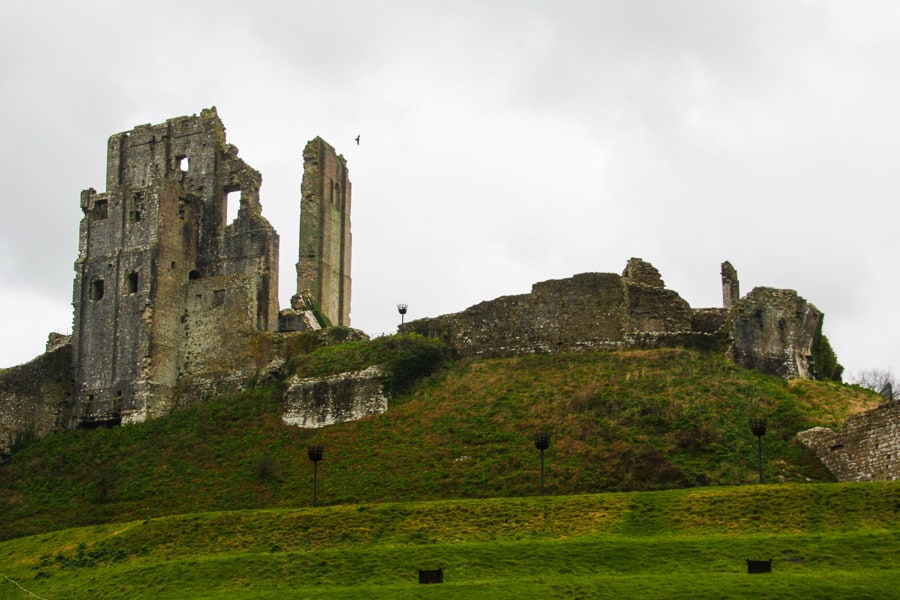
Durdle Door
Half-an-hour to the west of Corfe Castle is another spectacular geological showcase of the Jurassic Coast, the quirkily named Durdle Door.
It sounds like the gateway to somewhere magical, and being on the Jurassic Coast, it really is. Durdle Door is an impressive limestone arch at the head of crystal clear waters and a lovely crescent of beach. Striking white chalk cliffs rise and fall away to the west.
It’s a steep 15 minute walk from the carpark down to the beach, but worth it if the weather is nice. Otherwise, you could enjoy the view from above the beach and walk along the cliff path. If you hike east for 30 minutes, you’ll reach the lookout over pretty Lulworth Cove.
Durdle Door is near the village of West Lulworth. There’s a paid carpark which you can reach via the holiday park, and coastal walking tracks weaving off in both directions. Just be aware that this is a highly popular spot in summer and holiday periods and it may be difficult to find parking at those times.
The weather wasn’t awesome when we stopped by Durdle Door, so we were content to make this a short stop, take some pics and go for a brief wander along the clifftop trail. If you’d like to spend longer here, skip the next stop at West Bay.
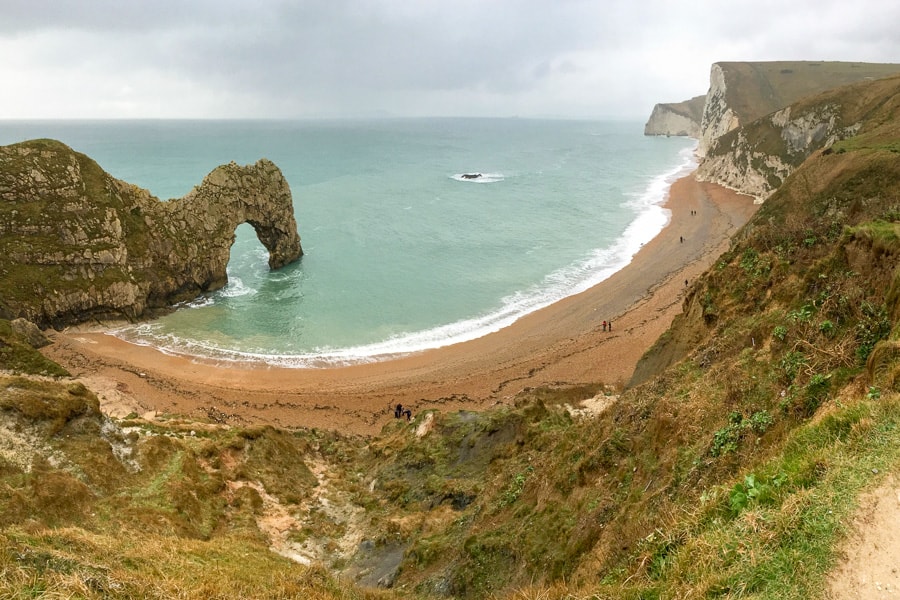
West Bay
A further 50 minutes’ drive around the Jurassic Coast will bring you to West Bay, a seaside village that doubled as the town of Broadchurch in the binge-worthy crime drama (the UK version).
A popular seaside holiday spot in summer, West Bay (which is also known as Bridport Harbour) was very quiet when we visited in the late wintertime. The sea was choppy and chocolate-milky but it certainly didn’t diminish the Jurassic Coast view we came here to see.
West Bay’s striking east cliff is a sheer, mustard-coloured sandstone rise, and could not be more different from the white chalk cliffs of this morning.
If you’re lunching here, pop by one of the fish and chip kiosks if they’re open, or settle in for a traditional ploughman’s lunch in one of the town’s seaside pubs as we did.
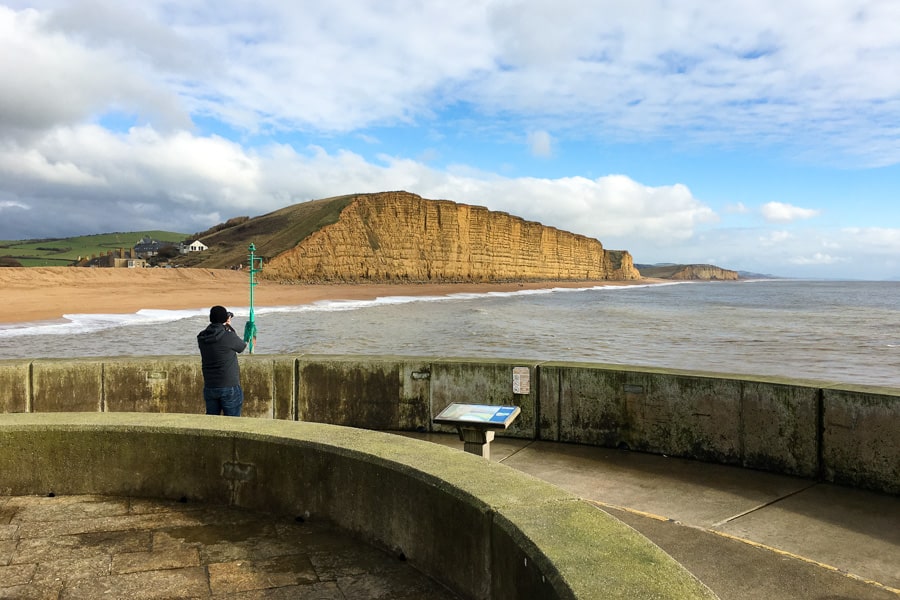
Travel tip: English pubs generally finish their lunch service at 3pm, although hours can vary on weekends, especially Sundays.
Lunching in a quaint village pub is a quintessential feature of an England road trip, so this is a critical piece of information when you’re planning your day, especially on packed days like this one.
Despite having lived in the UK on and off for years, we still turn up at pubs looking for a late-arvo bite to eat, only to find we’re too late. If it looks like you’re going to be pushed for time, aim for a high street bite instead.
Monmouth Beach, Lyme Regis
Our next stop is 25-minutes down the road from West Bay. Monmouth Beach is in Lyme Regis, which is world-renowned for its Jurassic Coast fossil treasure-trove and the pioneering work of palaeontologist Mary Anning.
If you’re into fossils and dinosaurs, you’ll want to give yourself more time here today so you can join a fossil tour and visit the museums.
First up, head to Lyme Regis Museum for a full immersion in the local fossil world. Guided fossil walks on the beach can also be organised through the museum, lasting around 2.5 hours.
A couple of minutes away, there’s also the Dinosaurland Fossil Museum, which has thousands of fossils on display.
Both museums have entry fees and varying opening hours, particularly during winter, so be sure to check their websites before visiting.
We missed the fossil walking tour sadly, but spent a happy hour on the beach anyway, trailing through the pebbles searching for fossils, which emerge and trickle down from the eroding cliffs above.
There’s also a very cool ‘ammonite graveyard’ here, which you can see at low tide around 15 minutes’ walk west of the carpark along the beach. Just be sure to check tide times before you visit and don’t attempt the walk while the tide is up.
If you’re interested in learning a little more about Lyme Regis, check out this self-guided smartphone heritage walk.
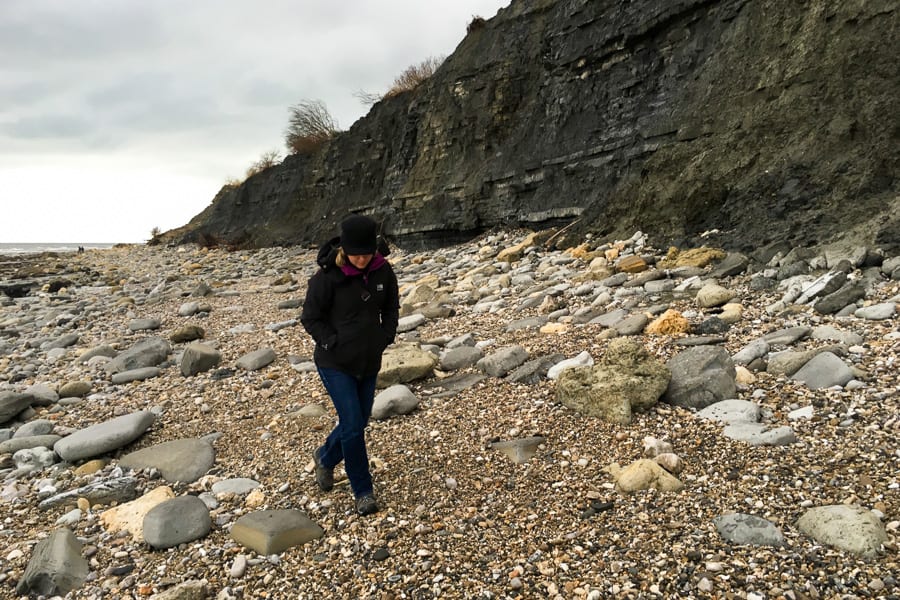
Where to stay in Lyme Regis
Lyme Regis is only small but there are a number of accommodations both in the town and in the surrounding countryside. The following stays get great reviews:
- Good value: Shepherds Hut – tiny home in rural setting | good facilities | free parking
- Mid range: High Tides – on the beach | renovated apartment in historic building | parking nearby
- Spend a bit more: Dower House Hotel – elegant and spacious rooms |excellent breakfast | onsite parking
Alternatively, if you’d prefer a larger range of choice for stays and dinner, you could continue on to the city of Exeter, about an hour’s drive to the west. This is what we did, staying at the Leonardo Hotel Exeter close to the city centre. With hindsight though, we would have preferred to stay in Lyme Regis on this night rather than make another hour long drive after dark, hence we’ve adjusted this itinerary.
Day 3 – Lyme Regis to Dartmouth via Exeter
Highlights: Exeter Cathedral | Exeter historic centre | Totnes Castle | Dartmouth village | Dartmouth Castle
Total driving distance: appx. 120km (75 miles)
Total driving time: appx. 2 hours 15 minutes
Overnight: Dartmouth
Exeter
This morning, you’ll be exploring the cathedral city of Exeter, so make your way there after breakfast. It’s around an hour from Lyme Regis.
Park up in one of the city’s central car parks. These are generally pay and display parking spaces. If you’re visiting during peak periods, there’s also a park and ride option for Exeter.
Exeter’s history goes back to Ancient Roman Britain, when this was a legionary military base on the edge of the Roman Empire.
The 12th century Exeter Cathedral was built during the city’s religious heyday and is one of the oldest in south west England. It’s an absolute must while you’re here. Be sure to head inside to see the cathedral’s magnificent ceiling, it’s the longest stretch of unbroken Gothic vaulting in the world.
Spend this morning exploring Exeter’s historic streets and sites. There are several self-guided walks you can do, which bring the city’s story to life through its ancient walls, its medieval period and the wool trade that brought it great wealth in the 17th century.
There’s also this fun, self-guided smartphone heritage walk you can do at your own pace.
Alternatively, a range of free 90 minute guided tours run each day from the Cathedral green.
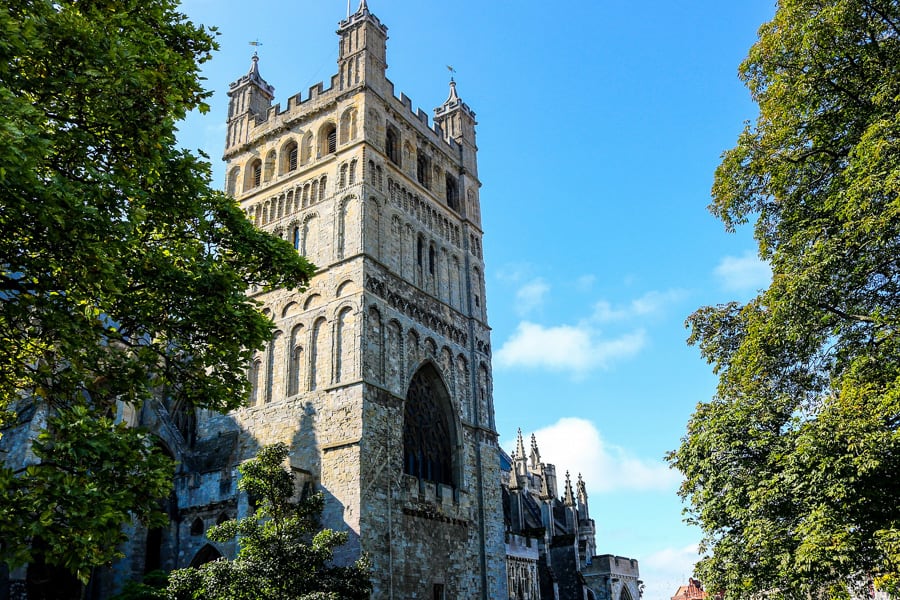
Totnes Castle
Our ultimate destination today is Dartmouth, but en route, you’ll be making a brief stop in the quirky market town of Totnes. It’s a 45 minute drive south west of Exeter.
Totnes dates back to Saxon times. Today, it’s known for its large artistic community, and thousand-year-old Totnes Castle, which is the focus of our visit.
This tiny hilltop fortress is renowned as one of the best preserved examples of a Norman motte (hill) and bailey (lower yard) earthworks still in existence.
Climb up to the stone keep and you’ll be rewarded with captivating views over the valley to the River Dart, and a garderobe (a medieval loo) still in situ. Wander the bailey below and keep an eye out for the tree graffiti left by prisoners held on site during WWII.
Totnes Castle is managed by English Heritage and there’s a fee to enter. There is pay and display parking nearby.
The Castle is open daily from 10am to 5pm, but it’s only open on weekends during the winter months. If you’re travelling in winter and today is a weekday on your itinerary, skip this stop and make straight for Dartmouth. It’s a 30 minute drive south.
Dartmouth
Sitting pretty at the head of the River Dart, the town of Dartmouth is a lovely little spot to while away this afternoon and evening.
Dartmouth was once an important fishing and trading port, and two medieval forts stand vigil at the entrance to the Dart Estuary to this day: Kingswear Castle and Dartmouth Castle. The latter is lauded as one of England’s most picturesque fortifications and it’s one of the showpiece castles of our south west England road trip.
There’s a paid car park close to the river and town centre. There’s also a cheaper park and ride option just outside of town, however the shuttle between the car park and town doesn’t run between November and late March (it’s around 30 minutes to walk to town).
Dartmouth’s cute little central streets are worth a wander, and there are a couple of self-guided town trails you can follow for an intro to the local history. The Castle Trail will take you along a section of the South West Coast Path from town to Dartmouth Castle.
The Castle’s passages and walkways offer stunning views and fascinating insights into its defensive history right up till WWII, including the set-up for the huge chain that could once be pulled up to block off the estuary mouth.
The site is managed by English Heritage, has a fee for entry and is open daily, except for the winter months, when it’s only open on weekends – check ahead if you’re keen to go inside.
If you’re visiting outside of winter, you can jump on the Castle Ferry for a 10 minute river cruise back to town. If you’d like to get out on the water for longer, there are a couple of other river boating options departing from town, like the one-hour Greenway Ferry river cruise.
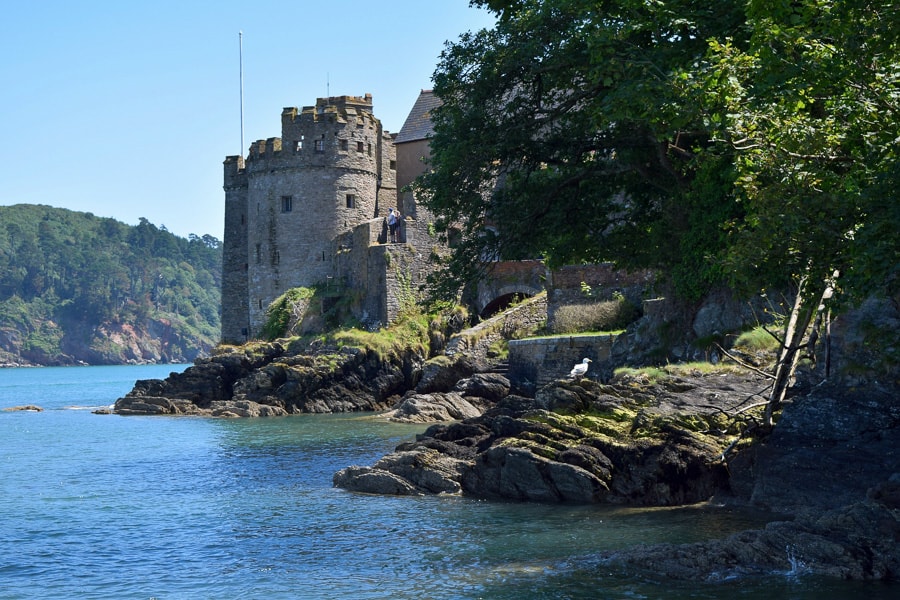
The Great Scone Debate
It’s a requirement of this itinerary that as you pass through Devon, you search out that most quintessential of English afternoon traditions: the cream tea. There are various places in Dartmouth you can stop for tea and scones, including the Dartmouth Castle Tearooms.
As you pay homage to the humble scone, consider this: there’s a very real divide in the UK about the etiquette of the cream tea, and whether jam or cream goes on the scone first.
In Devon, where cream tea is believed to have originated, the Devonshire tea tradition has cream on first followed by jam. Over the border in Cornwall, however, you put the jam on first then the cream.
We personally follow the Cornish tea tradition. Not that we’d quibble if it came out the other way. Try it both ways and you decide!
Where to stay in Dartmouth
Dartmouth is a small but popular town, especially in peak periods, and accommodation prices can reflect it.
We actually drove on for another couple of hours when we did this trip, but it was too much for one day. Hence we suggest staying in or around Dartmouth tonight. We’ve included a couple of local stays with great reviews below:
- Good value: St Elmo House – comfy rooms and beds | short walk to centre | street parking
- Mid-range: The Ship in Dock Inn – colourful rooms in historic building | central location | parking permits provided
- Spend a bit more: Harbourside 3 – modern rooms | overlooks river | free parking
Day 4 – Lizard Peninsula via Polperro, Cornwall
Highlights: Polperro | Truro Cathedral | Royal Cornwall Museum | Gweek Seal Sanctuary
Total driving distance: appx. 190km / 118 miles
Total driving time: appx. 3.5 hours
Overnight: Porthleven
Today you’ll cross into Cornwall, starting with the charming fishing village of Polperro and then spending the afternoon and all day tomorrow on the Lizard peninsula, known simply as The Lizard.
This wedge of land is one of the highlights of Cornwall, and a must-visit on our south west England road trip itinerary. Plus, the best way to experience this ruggedly beautiful stretch of Cornwall coastline is on foot. So having a couple of days in this area gives you more time out of the car, so you can get a proper feel for this wild corner of the country.
Travel tip: Take note today as you drive the bridge over the River Tamar on the western edge of Plymouth.
This is the ancient eastern boundary of Cornwall, set by King Athelstan in the mid-10th century to separate the feisty Celtic people in that part of the island from the newly united state of Wessex.
Speak to a Cornish person today and you may find sentiment isn’t much changed. As one local character told us over a beer in the historic Blue Anchor Inn at Helston, ‘This is Cornwall. Not England’.
Polperro
Polperro is a good 1.5-hour drive from Dartmouth so aim to set out early. This is a designated conservation area and, for us, it really does feel like wandering into another, older time. Winding lanes and charming stone cottages snuggle around a wee harbour where swans nap between the boats at low-tide.
You’ll need to leave your car at the paid public car park at the top of the village and make the 10-minute stroll down to the harbour along the canal and cute houses.
Once there, wander the pretty streets, look out for the Roman Bridge, and learn more about the history of this fishing village and former smuggler’s haunt at the tiny Harbour Museum, located in what was once the town’s busy pilchard factory (it’s closed over winter).
If you’re up for some lunch before moving on, then this is a great spot to sample another classic England tradition: fish and chips. There are some quaint old pubs in Polperro and we enjoyed a delicious pile of fish, chips and peas at the oldest of them, The Three Pilchards.
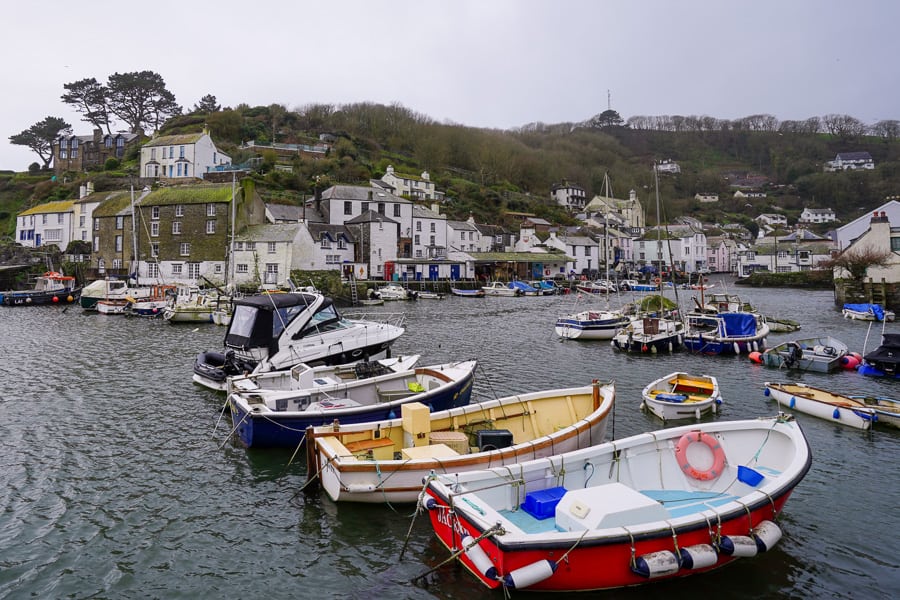
Truro
Our next stop is an hour’s drive from Polperro along the A30. Believe it or not, there’s only one actual city in Cornwall, and Truro is it. This is effectively the region’s capital and while it’s far from the madding crowds of London, it’s still busier than most places you’ll visit on this road trip.
Still, Truro makes a good spot to stretch your legs en route to The Lizard, particularly if you like a good cathedral and a museum showcasing the history of the area you’re exploring. Truro has both.
We were able to find a space at the paid Old Bridge Street Car Park, which is right around the corner from Truro Cathedral. This soaring gothic revival church was built in the late 1800s and has three spires, just one of three in the UK to do so.
Up the road you’ll find the Royal Cornwall Museum, which has a small but interesting collection of finds documenting Cornwall’s journey from prehistory to the industrial era. There are some other exhibitions in here too, including a random but quirky little Egyptian space with a mummy. There’s a fee to get in but it lasts a year.

The Lizard
Our final destination today is Porthleven and you’ll spend the next two nights here as you explore the Lizard peninsula.
Apparently ‘The Lizard’ comes from a Cornish phrase, ‘Lys Ardh’, referring to the area’s high cliffs, rather than any resident fauna or land shape. En route though, you will be making a stop to meet some local wildlife of a different kind.
Cornish Seal Sanctuary, Gweek
When we were planning to road trip south west England, we spotted a town on the map called ‘Gweek’. Of course we had to go there. What we found was the Cornish Seal Sanctuary and we’re forever grateful.
The sanctuary is a rescue centre for rehabilitating sick and injured seal pups. It’s a delightful place to linger, set on 40 acres by the picturesque River Helford.
In addition to plenty of opportunities to see and learn about the recovering and resident seals, including underwater viewing areas, it offers peaceful woodland walks by the tidal estuary. As of early 2024, the centre also has baby beavers!
The sanctuary is open every day from 11am to 4pm (last admissions at 3pm) and it’s advisable to book in advance. You’ll save on the ticket price if you book at least 2 days ahead.
Blue Anchor Inn, Helston
By now, it’s definitely beer o’clock and while you’re in this area, we highly recommend a visit to the Blue Anchor Inn in Helston.
The Blue Anchor is Cornwall’s oldest pub and it’s a little warren of low-ceilinged rooms with a properly ancient feel. We’ve spent a couple of memorable evenings here yarning with locals.
The onsite brewery has been in operation since the 15th century and is renowned for its medieval ‘Spingo Ales’. Our favourite is the rich and smooth ‘Middle’ ale but if you like beer then by all means, try them all (unless you’re driving, in which case, get a takeaway so you can try it later).
Afterwards, move on to your overnight stay in the lovely little fishing village of Porthleven, a 7 minute drive down the road.
Where to stay in Porthleven
Wee little Porthleven has a clutch of accommodations tucked into the streets around the harbour. More options can be found in nearby Helston and in the surrounding area. We suggest the following stays, they all have great reviews.
- Good value: No 52 bed and breakfast (Helston) – on the high street | nicely decorated rooms | great breakfast (we’ve stayed here and it was a convenient overnighter, with parking a 5 minute walk away or free overnight street parking right outside if you can swing luck and timings. It’s also virtually next door to the Blue Anchor Inn – no excuse not to try those Spingo ales!)
- Mid-range: Harbour Inn (Porthleven) – historic pub stay | right on the quay | really friendly staff (we’ve also stayed here and love the location; we parked in the Kitto’s Field Long Stay Car Park, a 2 minute walk away)
- Mid-range: The Artist Loft (Porthleven) – comfy beds | very short walk to harbour | free parking
- Spend a bit more: Housel Bay Hotel (The Lizard) – If you’re after something special, have a look at this grand hotel. We hiked past it on the Lizard loop walk (see tomorrow’s itinerary) and we’ll be back one day to stay. It’s perched high above the cliffs overlooking the Atlantic and offers direct access to the South West Coast Path. It has a minimum 2 night stay and parking onsite.
Day 5 – Lizard Peninsula
Highlights: Porthleven Harbour | Kynance Cove | Lizard Point | Lizard loop walk | Halliggye Fogou
Total driving distance: appx. 45km (28 miles)
Total driving time: appx. 1 hour 15 minutes
Overnight: Lizard Peninsula (Porthleven or Helston)
Day 5 of our south west England road trip has you exploring more of the spectacular coastal landscapes of Lizard Peninsula in Cornwall.
Start your morning with an early stroll around Porthleven harbour. This is the UK’s most westerly port and, with its 19th century inner walls, is an important safe harbour on a coastline notorious for shipwrecks over the centuries.
The creation of the harbour also unintentionally turned Porthleven into one of the UK’s best surf spots. We stopped for a bit to watch some hardy souls braving the freezing swells crashing onto the harbour wall.
The Harbour Markets run on various days throughout the week and year. If you’d like to slow the pace today, hang around and check out the markets from 10am and then pick and choose from the rest of today’s suggested destinations around The Lizard.
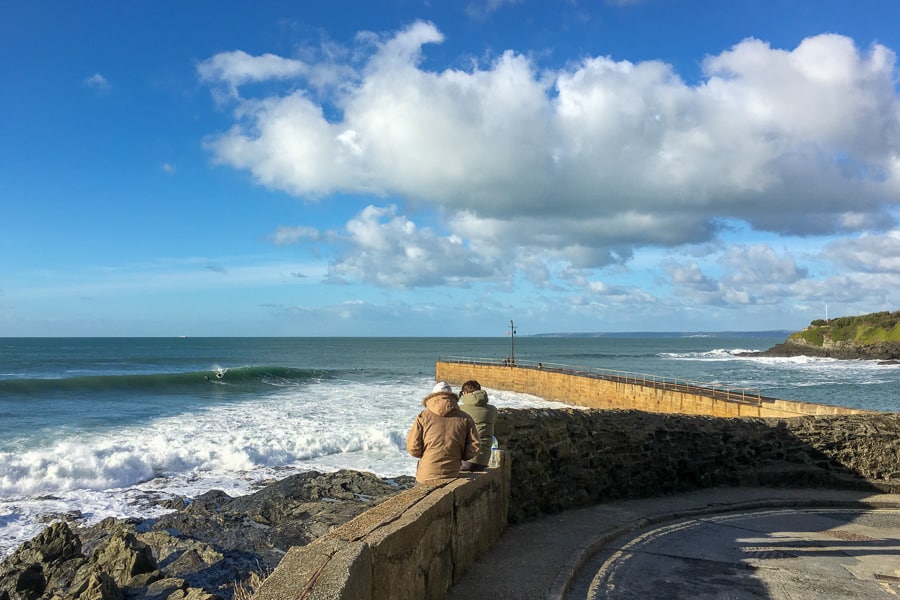
Kynance Cove
From Porthleven, set out to explore the rest of the peninsula by car, starting with the legendary Kynance Cove, a dramatic landscape of rocky outcrops, white sand and crystal clear water. It’s around 40 minutes south.
Kynance Cove often makes lists of the world’s best beaches, with pearly white sand and turquoise water, which is why it made it on to our itinerary. We were also keen to get up close with the famous red and green serpentine rock stacks to be found here.
We found Kynance to be ruggedly dramatic but our visit was on a day of wild weather so we didn’t get to see it in all its list-making glory. Hopefully you do!
Park up at the National Trust car park and make your way down the steep and rocky path to the beach. Be sure to check tide times before you do though as the beach can disappear completely under a high tide.
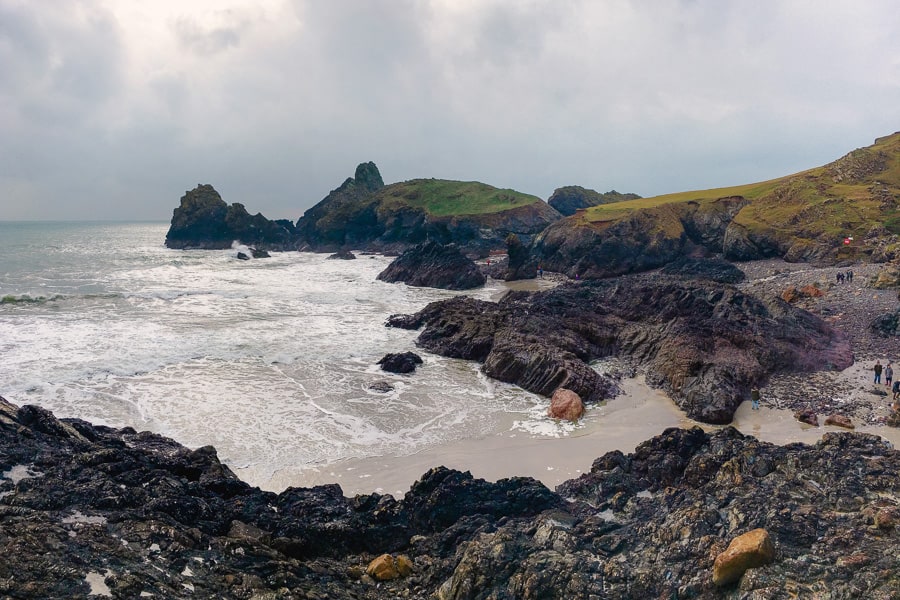
Lizard Point
Twenty minutes from Kynance Cove is our next destination, Lizard Point. This is the southernmost tip of Lizard peninsula (and the UK in fact).
This is a prime opportunity to stretch your legs on another section of the South West Coast Path. This segment is a 6.5km loop walk of Lizard Point.
The Lizard loop walk starts and finishes in the village of Lizard, so make your way there and park on the village green. There are a number of cutbacks along the way if you’d prefer a shorter walk.
Alternatively, you can park further towards the point at the National Trust car park and enjoy a short walk to the southernmost point lookout, or along the coast in either direction.
This coastline around Lizard Point is rugged, beautiful…and lethal. The ocean off the headland has been a graveyard for ships for about as long as people have braved the seas here.
While our first attempt at the Lizard loop was thwarted by wild weather, we’ve since returned to complete the hike and can confirm it is 100% worth doing if you have the time and inclination (and the weather is cooperating). It ranks very high on our list of awesome things to do in south west England. Set aside around 3 hours to do the full walk, with stops along the way.
Travel tip: Keep an eye on the weather if you’re planning to walk The Lizard coastline. And do stop by Polpeor Café at Lizard Point. We retreated here to wait out the storm on our first visit and drip dried over the biggest scones we’d ever seen.
Cornish tea on the cafe’s terrace overlooking the ocean would be superb on a sunny day. The café closes at 4pm (or as weather dictates).
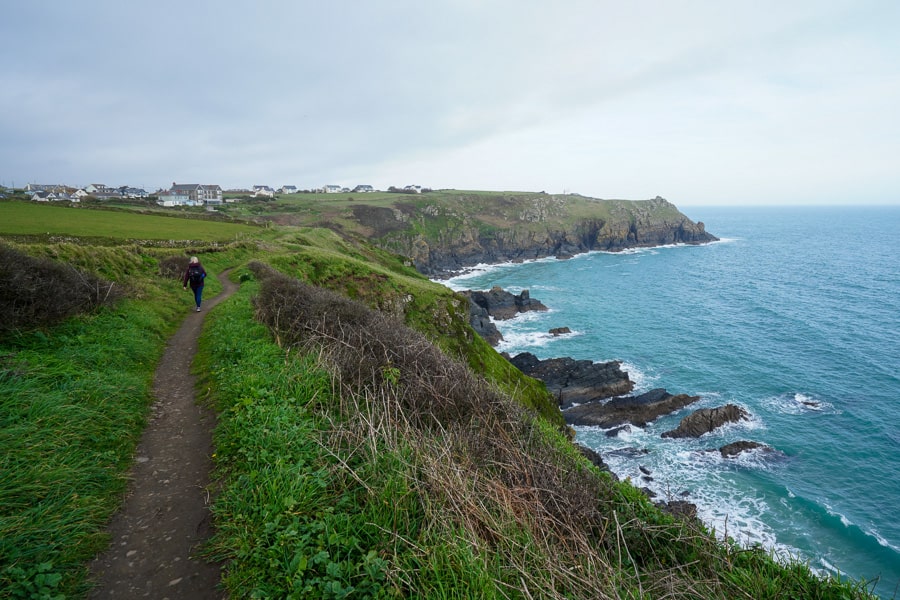
Halliggye Fogou
Sounds like something a Viking might say, but Halliggye Fogou is the name of an Iron Age site on The Lizard.
Halliggye Fogou is around 20 minutes north of Lizard village. En route, make a quick pit stop at the Old Cider Barn Arts & Crafts Centre to check out the bric-à-brac and perhaps pick up some traditional Cornish cider.
A ‘fogou’ is a Cornish word for ‘cave’ and at these sites, it refers to networks of underground passages built in stone around 2,500 years ago as part of Iron Age farming settlements. Their purpose is unknown.
Halligye Fogou is managed by English Heritage, is free to visit and open during the day, although you can’t go inside the fogou over the winter months.
Day 6 – Penwith Peninsula, Cornwall
Highlights: St Michael’s Mount | Penzance | Merry Maidens Stone Circle | Minack Theatre
Total driving distance: appx. 40km (25 miles) plus the drive to your chosen accommodation
Total driving time: appx. 1 hour plus above
Overnight: Penwith Peninsula
We’re up early today for a time travel through the Penwith peninsula, home to western Europe’s largest concentration of ancient sites and arguably the gem in Cornwall’s crown.
Whether you do it as part of a longer driving adventure like this one or on its own, we reckon the Penwith peninsula is one of the best UK road trips you can do.
There’s a huge amount to see over the next two days. Penwith peninsula is small enough though that you could reorder any of the sites and experiences to suit your interests and timings (it takes around 30 to 40 minutes to drive the length of the peninsula between St Ives in the north and Land’s End in the south). There is a fair bit of driving to see all the things, but you’ll be getting out of the car often.
You’ll also be spending two nights in this region so you can choose to base yourself in one spot for both nights as you explore the peninsula, or stay in two places and max your time around each area.
Travel Tip: Before you leave Porthleven this morning, don’t pass up the opportunity to pick up another local-gone-global speciality that you absolutely must indulge in while travelling around Cornwall: the Cornish pasty.
If you’ve never encountered one before, pasties are baked flaky pastries folded over a savoury filling. The traditional filling is beef and veg, but you can get all sorts of fillings, as well as gluten-free and vegan options.
There are a couple of excellent pasty bakeries in Porthleven (and right across Cornwall). We picked up a giant pasty to-go from Philps Pasty Shop. Whatever else you do, do this. In fact, get two. It was one of our great regrets that we only bought one the first time we visited and had to share it.
St Michael’s Mount
Today’s sightseeing is dictated by the tides, so we encourage you to check the local tide times and plan today’s itinerary to suit.
The reason for this is that you’ll be visiting St Michael’s Mount offshore from Marazion, and if you visit at low tide, you can walk across the causeway.
You can also take a boat to St Michael’s when the tide is in. But there’s something special about walking the ancient cobbled causeway across to this offshore rock before climbing the steep path to explore the castle.
It’s no coincidence that St Michael’s Mount bears the hallmarks of Mont Saint Michel, the impressive monastery-capped tidal island across the English Channel off Normandy in France. It was a monk from Mont St Michel who commissioned the monastery on St Michael’s Mount in the 12th century.
For the last four hundred years or so though, this has been the seat of the St Aubyn family and they still live there today.
It’s 20 minutes from Porthleven to Marazion and there are a couple of paid car parks in the area opposite St Michael’s Mount. You’ll need to book your tickets in advance. Check out this website.

Penzance
From Marazion, make your way to the historic market and port town of Penzance, backdrop to the famed play, The Pirates of Penzance.
While the comic opera is a fiction, piracy and smuggling did give this coastline a notorious reputation for hundreds of years. By the 19th century though, Penzance was a fashionable seaside resort.
Head to the Harbour Long Stay Car Park and spend a couple of hours wandering Penzance’s streets and gardens. This self-guided walk will introduce you to the town’s history and key spots.
Merry Maidens & Tregiffian Burial Chamber
Our next stop is the Merry Maidens Stone Circle. You’ll find it in a field by the side of the B3315 road around 6km south of Penzance.
The 19 standing stones here were erected in the mists of time, somewhere between 3500 and 4500 years ago. It’s not known why the circle was built, but it’s thought to have been a sort of astronomical tracker and ceremonial site. When we visited, we had the ambient stone circle all to ourselves.
Walk a little further along the road on the same side and you’ll come to the Tregiffian Burial Chamber. This large neolithic chambered tomb was damaged in the creation of the road, but it’s still an interesting example of what’s known as an ‘entrance grave’.
If you’re particularly keen, there’s also a tall menhir stone called Gun Rith in the field opposite this site. Like the tomb, it’s believed to be linked to the Merry Maidens.
All of these sites are free and can be accessed from a small layover parking area on the left side of the B3315 as you head south west – look out for the bus stop sign. For the stone circle, climb the steps over the gate and head into the field.

Minack Theatre
From the Merry Maidens, it’s a 15 minute drive to stunning Minack Theatre, the single-minded creation of the extraordinary Rowena Cade, and possibly one of the most spectacularly-sited open air theatres since the ancient Greeks and Romans were in the business.
It’s recommended you book your visit to Minack in advance as there is timed entry. Opening days and hours also vary so check ahead.
The 750-seat theatre built into the rocky cliffs is impressive enough on its own, but if you can, try and time your visit for a performance. The theatre season for 2024 runs from late March until late September, with mainly evening but some afternoon shows. We’ll definitely be back to do this.
Where to stay on the Penwith Peninsula
You have tonight and tomorrow on the Penwith peninsula so you could opt for two nights in one place and use that as a base, or stay in two different parts of the peninsula.
Your choices in this area are extensive, and range from boutique B&Bs and guest houses to self-catering seaside cottages, remote pub stays and luxe hotels. There are also campgrounds and holiday parks right across the peninsula.
If you’d like to stay in a slightly larger town with more amenities and eating options, look to quirky Penzance or chic St Ives, or another village on the peninsula like Zennor or Mousehole. Aim to book well ahead if you’re planning a visit during summer or holiday periods.
We personally stayed near the village of Zennor at The Gurnard’s Head, a beautiful historic inn surrounded by coast and countryside. It’s a short short drive from St Ives and they have a fantastic restaurant serving up local seasonal deliciousness.
Day 7 – Penwith Peninsula, Cornwall
Highlights: Land’s End | Boscawen-ûn Stone Circle | Carn Euny Ancient Village | The Tin Coast – Botallack Tin Mine
Total driving distance: appx. 25km (15.5 miles) plus travel to and from your accommodation and any additional activities today
Total driving time: appx. 45 minutes plus the above
Overnight: Penwith Peninsula
Our view when we awoke in Zennor was of rolling moors and cows gathering on the road outside. This is another truly stunning stretch of Cornwall coastline. With an array of walks winding through moorland and along cliffs scattered with tin mine ruins, you could easily spend the day in this area alone.
For your second day in the Penwith area, however, you’ll be exploring the west coast and heartland of the peninsula, and more of the historic sites that set this ancient corner apart.
Depending on where you’ve stayed overnight, you might reorder the following sites to suit. Otherwise, make your way first to Land’s End.
Land’s End
There’s something strangely compelling about standing at the most extreme ends of a place, and that’s the draw of England’s most westerly point, Land’s End.
The Atlantic views here are spectacular, but be prepared for the crowded theme park it is. If the ‘attractions’ and gift shops don’t appeal, do as we did and make for the coastal paths.
There’s an easy 4.9km loop walk starting and finishing at the Land’s End car park, which you might consider if you want to make time for it today. Otherwise, take a short stroll along the cliffs and soak up the views instead.
Boscawen-ûn Stone Circle
We haven’t been ourselves, but if you’re keen to go searching, there’s another impressive prehistoric ring of monoliths en route from Land’s End to our next stop, Carn Euny.
Boscawen-ûn Stone Circle is believed to have been a significant ceremonial centre in its day. Like the Merry Maidens, there are 19 standing stones here, one of which is notably made of white quartz.
There’s access to the stone circle via a signposted path from Boscawen-ûn Farm, though apparently parking is tricky along the farm lane. Instead, on your way from Land’s End, keep an eye out for a layover on the right hand side, about 800 metres before the farm lane. You can park here and there’s a sign and path to the stone circle.
Carn Euny Ancient Village
There are two fascinating ancient settlement sites on the Penwith peninsula, Chysauster and Carn Euny.
Chysauster Ancient Village, around 15 minutes north of Penzance, is a 2000-year-old Romano-British settlement with stone-walled houses. It’s managed by English Heritage and there’s an entry fee. It’s closed over winter.
The other site, around 20 minutes inland along the A30 from Land’s End – and the one we visited – is Carn Euny Ancient Village. It’s also managed by English Heritage but it’s free and open during the day year-round. It does, however, require going off-piste around 600 metres from the small car park through farmland that can get seriously squelchy when it rains.
Carn Euny was inhabited from Iron Age to Roman times, and features stone house foundations and another of those mysterious underground passages called a fogou. The site serves up impressive views for miles around.
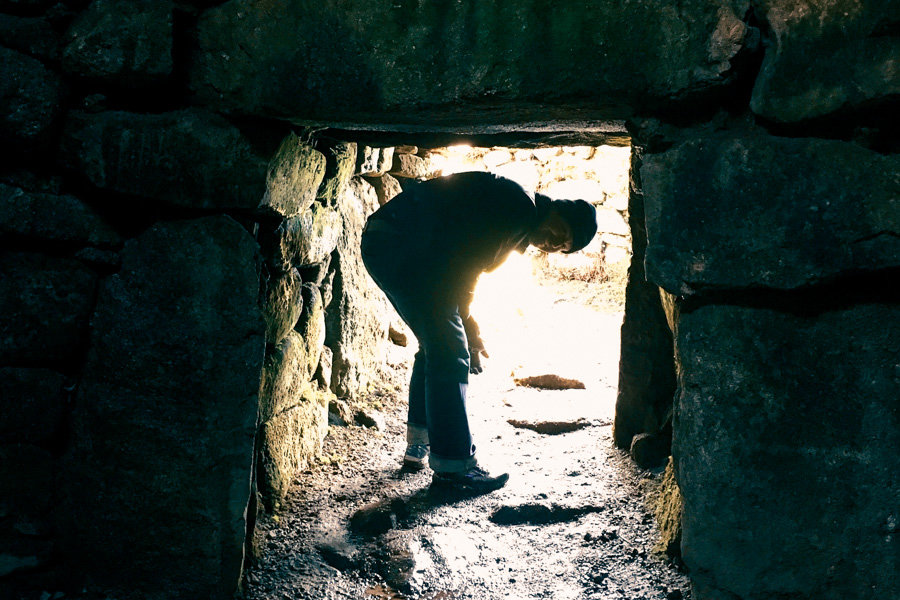
The Tin Coast
People have been digging metals out of the earth in Cornwall for four thousand years. Today, the remnants of historic mining sites and engine houses pockmark the region.
In fact, mining is such an important part of the Cornish story that the ‘Tin Coast’ has been declared World Heritage, and there are a number of sites where you can get your Poldark on.
At Botallack, a National Trust site 20 minutes from Carn Euny Ancient Village, you can follow the paths on this map to see the impressive 19th century engine houses clinging to the cliffs, and the shafts, chimney stacks and other remnants of the busy mining site this once was. There’s parking just past Botallack Count House.
Less than 10 minutes north is the Levant Mine and Beam Engine, another National Trust site. Among the mine buildings and industrial remains here, there’s a working 19th century steam-powered beam engine. The site can only be visited on a 1.5 hour pre-booked tour, but it’s a great way to learn more about the history of tin mining in the region and the perils of the industry.

More exploring on the Penwith Peninsula
If you’ve still got energy (and daylight hours), there are plenty more ancient sites dotting the Penwith peninsula.
Two other great sites in the northern area include the 5000 year-old Lanyon Quoit, a classic stone dolmen thought to have been a burial chamber covered in earth once upon a time. Near the quoit, you’ll find Chûn Castle, a 2500 year-old circular Iron Age hillfort.
There are also a ton of opportunities to get outdoors and explore on foot. The epic South West Coast Path traverses the entire coastline, while hundreds and hundreds more kilometres trail across the countryside.
The Epic South West Coast Path
One of the most impressive discoveries when you road trip England’s south west is that there’s also a walking trail winding its way along most of the coastline!
The South West Coast Path is the longest national trail in the UK, stretching around 1,015 kilometres (630 miles) between Poole Harbour at the eastern end of the Jurassic Coast, right around to Minehead in the north of Devon.
This is definitely on our list of long (loooong) walks we want to conquer in our lifetime. But the great thing about the South West Coast Path is that you can get out of the car and stretch your legs on short lengths of the trail virtually everywhere you stop along the coast.
There are hundreds of short loop walks you can do, which you can find here. Or just park up and set off for a stroll in either direction. Being able to do this is one of the absolute highlights of this south west England road trip itinerary.
Day 8 – St Ives to Padstow
Highlights: St Ives | Fistral Beach, Newquay | Wine & cider tasting | Padstow
Total driving distance: appx. 80 km (50 miles) plus travel to St Ives from accommodation
Total driving time: appx. 1.5 hours plus above
Overnight: Padstow
Today, we’re heading further north into western Cornwall to visit a couple of the region’s most famous seaside villages: St Ives and Padstow.
Between the two towns, there are a couple of activity options today. Just note that if you do the boat trip out of Hayle, you’ll spend most of the day in St Ives.
St Ives
Start today with a coffee in boho St Ives. We’d seen so much written about this place over the years, we just had to come and see for ourselves what all the fuss was about.
Summer in this fishing-village-turned-art-hub can be chaotic but we’d heard it could be a ghost town in winter. Not so on the day we visited. The sun was out and by mid-morning, the harbour-front was humming with people and the small beach was filling up.
We popped into a tiny, side-street café and then wandered the streets. There’s no shortage of pubs, bakeries, bric-à-brac shops, museums and galleries. You’ll also find the highly regarded Tate St Ives Gallery, for which you can book a visit ahead of time here.
Parking can be a challenge in St Ives, especially in the peak. Perhaps the nicest way to get in and out without losing time searching for a car space is to park up at St Erth Station over in the nearby village of Hayle, and take the 10 minute ‘park and ride’ train to St Ives. You’ll have gorgeous sea views as you travel into the village along the coast. The train runs twice an hour, every day.
St Ives Station is also the starting point for this 3km self-guided walk around the town.
If you are parking at Hayle, you might also consider spending more time in this area today and doing a boat trip like this one to experience the dramatic Cornwall coastline from the water. Boat trip itineraries usually depend on the weather, but some do head out to nearby Seal Island to visit the local seal colony.
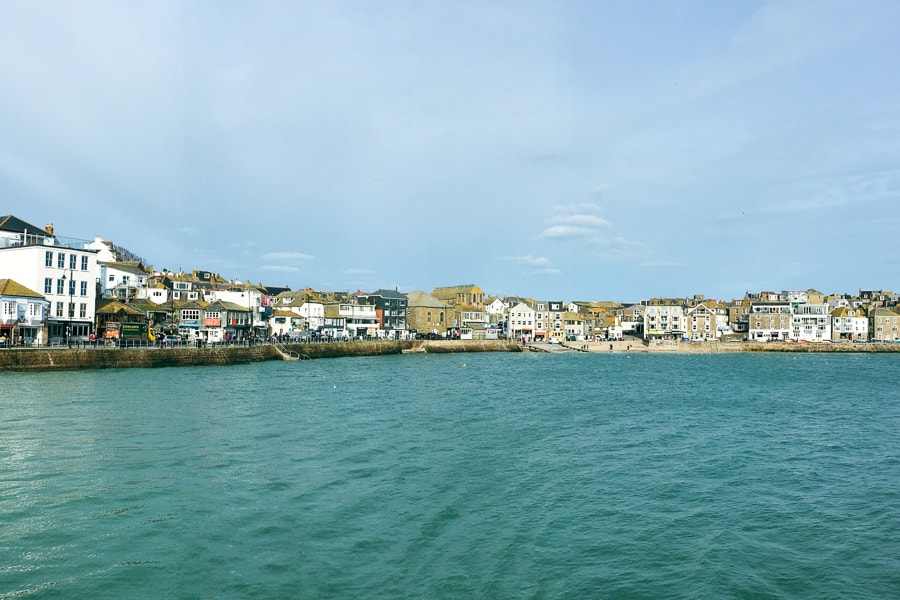
Surf’s Up or Bottom’s Up?
From St Ives, it’s a 1 hour 15 minute drive north to the wee fishing village of Padstow. On the way though, you have a couple of diversions to choose from.
Newquay
En route to Padstow, you’ll pass the town of Newquay, home to the UK’s most famous surfing beaches.
This is a very popular seaside getaway for Brits, especially in summer. It’s also renowned as a bucks and hens party destination and has the nightlife to go with it.
We’ve opted not to include Newquay in this itinerary as it’s a bigger town and we feel there are other, prettier places to visit in this area. However, if you’d like to see why the beaches here are considered surfing meccas, you could break up today’s journey to Padstow with a stop at the most popular surf spot, Fistral Beach.
There’s a paid car park at the beach and various shops and places to eat (including a well-priced Rick Stein restaurant) at the International Surfing Centre.
It’s also worth noting that there are more budget accommodation options here if you’re looking for an alternative to the higher prices in St Ives and Padstow for tonight’s accommodation.
Wine tasting and vineyard tour
If wine trumps beach for you (it most definitely does for us), then a lovely alternative as you head towards Padstow today is a wine tasting or tour at Trevibban Mill Vineyard.
English wine’s star is definitely rising and we absolutely recommend taking the chance to sample locally grown and produced vino and cider at this beautiful, high-ceilinged establishment overlooking the countryside. They also serve delicious grazing boards. Check their website for availability.
Padstow
Charming Padstow has its share of highlights, but it’s also garnered something of a reputation for its food scene. In fact, this was the catalyst for our original London to Cornwall road trip.
As far away as Australia, Rick Stein’s way with seafood is legendary and Padstow is where his business empire first flourished. These days there are four Rick Stein restaurants in the village. We decided to go to the source, The Seafood Restaurant. We packaged it up with a stay in one of Stein’s nearby hotels.
This is just one of many awesome eating opportunities in Padstow however, from the upmarket to the understated. If you don’t feel like a flashy meal this evening, go for a bag of takeaway fish and chips (there’s a Rick Stein joint for this too) and head to the harbourside.
Food aside, this medieval fishing village is a nice little place to spend the late afternoon, particularly down by the working harbour. Across the water, you’ll see the village of Rock, a posh escape for the rich and famous. Ferries cross back and forth during the day (there’s a timetable down on the pier).
A wander through the backstreets of Padstow will bring you to the 15th century St Petroc’s Church. This has been a site of worship since the year 518AD and has all the feels of a very ancient place. Outside of the winter months, you can also visit the 16th century manor house, Prideaux Place.
There are a couple of car parks down by the harbour in Padstow but they can fill quickly. We lucked out with a space in the South Quay Car Park. Otherwise, there are a couple of parking lots up the hill, including Padstow Main Road Car Park, a 10 minute walk into town. All of the car parks are paid parking. If you’re staying in town overnight, check with your accommodation provider for your best parking options.
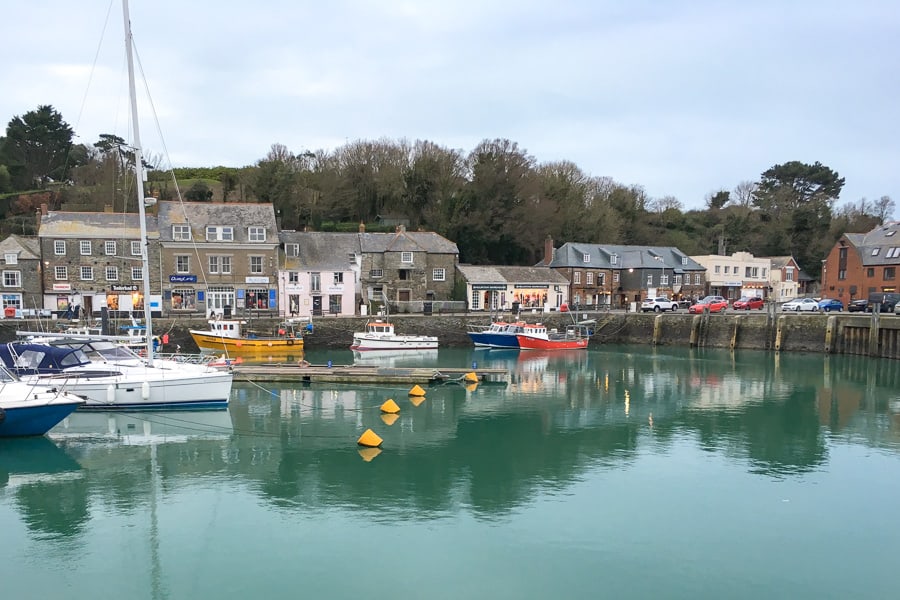
Where to stay in Padstow
For a small village, Padstow has lots of accommodation, reflecting its popularity. But it can book out well ahead of time. Cast the net wider if needed as there are also lovely stays in the area surrounding Padstow.
- Good value: Drang House – excellent location | clean & comfy | historic building
- Mid-range: The Old Custom House – cosy pub stay | overlooking the harbour | great brekkie
- Spend a bit more: Harbour Hotel Padstow – harbour front | lovely views | great staff
Rick Stein also has a range of accommodations in Padstow, complementing his restaurants around town. We stayed in a very cosy room at Rick Stein’s Café, part of a birthday splurge including dinner at his famous Seafood Restaurant.
Day 9 – Port Isaac & Tintagel
Highlights: Fishing village of Port Isaac | Tintagel Castle & Village
Total driving distance: appx. 40km (25 miles) plus any additional exploring in this area
Total driving time: appx. 1 hour plus the above
Overnight: Tintagel area
Today you’ll set out into northern Cornwall to visit a charming historic village and the legendary birthplace of King Arthur, Tintagel Castle.
Leaving Padstow by 9am, make your way north 30 minutes to the tiny fishing village of Port Isaac.
If you’ve yet to have breakfast (or you’re ready for second breakfast), consider stopping en route at the St Kew Farmshop and Café along the A39 for a bite. We stopped here briefly to browse the pantry and the smells coming from the café were divine! It opens at 9am six days a week (it’s closed Sundays).
Port Isaac
Pretty Port Isaac, with its white cottages decorating the coastal clifftops and the narrow harbour, is the famous ‘Port Wenn’ of the TV series Doc Martin.
Park at the paid New Road (St Endellion) Long Stay Car Park at the top of the hill and wander along the sea path down into the village.
Take an hour or two to enjoy a stroll along the tight paths between the village’s cottages, shops and pubs, keeping an eye out for the narrowest of them all, ‘Squeezy Belly Alley’.
If you’re a fan of the Doc Martin series, you might want to stay a little longer here and make time for this 1.5 hour guided Doc Martin tour of the town.

Tintagel Castle & Village
It’s a drive of around 25 minutes from Port Isaac to the dramatic bluff where Arthurian myths have swirled for centuries.
We weren’t sure what to expect on our first visit, but Tintagel and surrounds has turned out to be one of our favourite places to visit in south west England.
There are five paid car parks in the village of Tintagel. We usually get a space at the good-sized King Arthur’s Car Park in the centre of the village.
Aim to spend the afternoon in and around Tintagel Castle and village.
Tintagel Castle
Crowning two dramatic clifftop sites joined by a long bridge, the evocative crumbling ruins of Tintagel hint at the serious fortress it once was.
The rocky outcrop on which part of the castle clings is also scattered with the stone remains of a Dark Age settlement.
Tintagel Castle is open daily from 10am to 5pm but check the website before visiting as it can be closed during high winds and poor weather, and isn’t open every day during the winter period.
It also has timed entry and can get busy, so while you can buy a ticket on the day, it’s useful to book ahead if you can. You’ll save money by booking in advance online too, up till 8.45am on the day you visit. The castle is managed by English Heritage.
There’s a steep hill down and some stairs up to reach the castle bridge. There’s also a land rover that runs visitors up and down for an additional fee.
Spend a couple of hours wandering all over and re-imagining this mythical site. Don’t miss the ethereal sculpture, Gallos, on the far side of the island – it’s a fitting tribute to Tintagel’s mystique.
Travel Tip: For sensational views of the coastline here and of Tintagel island itself, we highly recommend heading out for a walk along the South West Coast Path to the right and/or left of Tintagel Castle.
We’ve walked both sides and both serve up fantastic scenery and different perspectives of the castle, bridge and island. The weather was wild when we last hiked but it was exhilarating all the same.
On the south side, you can also walk along the coast path to the spectacularly-sited 12th century St Materiana’s Church. For a shorter walk, you can park at the church and head along the path towards Tintagel instead.
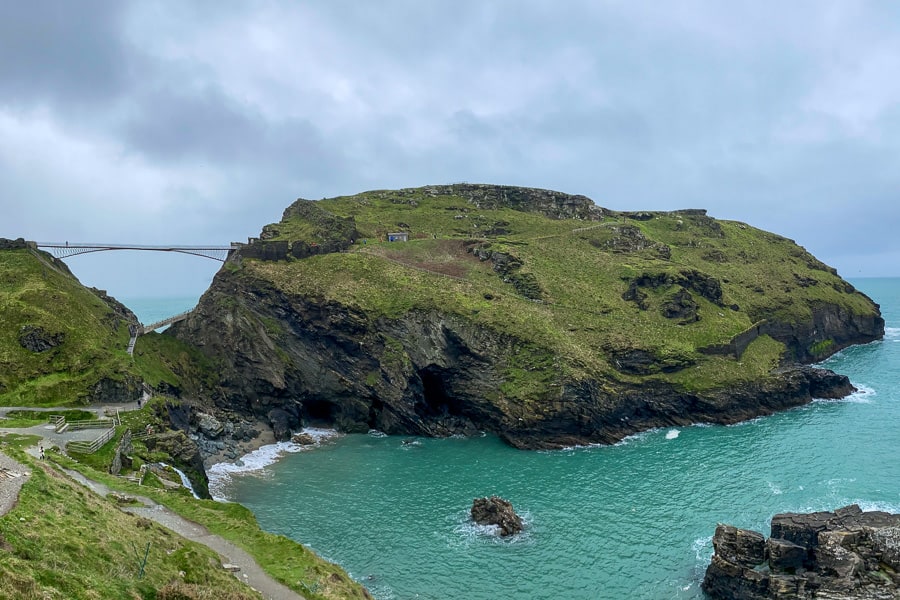
Tintagel Village
Once you’ve finished exploring Tintagel Castle, take a stroll through the village high street.
When you see a higgledy-piggledy, ancient-looking stone and slate-roof building, you’ve reached the Tintagel Old Post Office, a cottage from the 1300s.
This is a National Trust site set up as it would have been several hundred years ago when the cottage was a Victorian post office and home, with lots of insights about life in earlier times. We weren’t here long but found it a quaint and fascinating little spot.
Unless you’ve had lunch on the go, you have plenty of options for a late lunch or early dinner in Tintagel village.
Alternatively, take a 10 minute drive into the nearby countryside for a stop at beautiful Tintagel Brewery Bar & Bistro for a paddle of beers and something delicious from their menu (we’re still talking about the pork belly Scotch egg with Thai spiced sauce we had here). Check their website for opening hours and serving times.
Where to stay in Tintagel and surrounds
Tomorrow, you’ll be spending a good part of the morning in the area between Tintagel and Boscastle and there’s a range of accommodation in and between both villages. So you can either stay in Tintagel tonight, or in Boscastle, or anywhere between. Boscastle is just 10 minutes up the road.
The following stays get great reviews:
- Good value: Bosayne Guest House – friendly and welcoming | near to beach and Tintagel village | free parking
- Mid-range: King Arthur’s Arms – historic pub stay | centre of Tintagel | free parking
- Spend a bit more: The Wellington Hotel – elegant, historic building | centre of Boscastle | free parking
Day 10 – Boscastle to Exeter via Bodmin Moor
Highlights: St Nectan’s Glen Walk & Waterfall | Boscastle fishing village | Bodmin Moor
Total driving distance: appx. 145km (90 miles)
Total driving time: appx. 2.5 hours
Overnight: Exeter
Today you’ll explore some of the natural and historic man-made highlights of this area before leaving Cornwall as you start your journey back east.
Depending on where you’ve spent the night, you can do either Boscastle or St Nectan’s Glen first this morning. St Nectan’s Glen is between Tintagel and Boscastle.
St Nectan’s Glen & Waterfall
After a couple of days of poor weather and muddy trails, we very nearly passed up this little nature trail. We’re really glad we didn’t. St Nectan’s Glen and Waterfall is a real delight and wholly unexpected when you park up in the gravel car park off the B3263 road.
Have £3 in coins with you for the pay and display car park as it’s cash only. Also, wear your decent walking shoes as it can get muddy and there are a bunch of slippery steps at the visitor centre and waterfall.
From the carpark, follow the signs to cross the road, head up the short path and then off to the right. Soon enough, the trail will start to follow alongside a lovely bubbling river through a mossy, green forest.
You’ll climb quite a few stairs out of the glen to the visitor centre, where you pay an £8 entry fee and then head back down a heap more steps on the other side of the river. If you go this route, you’ll need to wade into the river to see the falls. We took our shoes off and embraced the freezing, ankle-deep water to go and stand in the spray of the cascade. It’s magic.
Once you climb the steps out again, you can stop by the café before making your way back through the glen, or looping out and back to the car park along a very rough and ready single-lane dirt road. We went this way and can confirm it’s an easier downhill walk but far less picturesque.
The trail is open anytime, but access to the waterfall and visitor centre is daily from 9am to 5pm. We suggest being on the trail around 8.30am and getting to the centre for opening. Give yourself around 1.5 hours to do the walk there and back, with some time at the falls.

Boscastle
Ten minutes north of the St Nectan’s Glen car park and 15 minutes north of Tintagel, tucked into a small inlet between narrow and winding sea cliffs, you’ll find the tiny harbour village of Boscastle. This was another marvellous little stop for us, and definitely worth a visit.
Park up at the paid Cobweb Car Park. A river runs through the village along a shale-stacked canal and meets the sea at a quay built in Elizabethan times. Pretty stone cottages and some ancient looking buildings line the way.
Enjoy a wander through the hamlet and stop for a break in one of the tea rooms or at The Wellington, a 16th century coaching inn. Look out for the red telephone box out the front that’s been converted into a donation-based second-hand bookshop.
If the spirit of Tintagel has fired up your interest in legends and myths, there’s a Museum of Witchcraft and Magic in Boscastle (it’s closed during winter). The Wellington is also said to be haunted!
In our opinion, the real magic happens here with a walk out along the right side of the bay, up to the high shale rock pile that forms a natural protective barrier for the village. From up there, you’ll have views only nature can conjure, right out over the Atlantic and the coastline and back towards the village.

Bodmin Moor
From Boscastle, make your way inland and take the A30 road into the granite wilds of Bodmin Moor. There’s only time to visit a couple of the many sites – natural and manmade – that make this landscape so special, but don’t leave Cornwall without at least a drive through part of this ruggedly beautiful place.
Hurlers Stone Circles
Our first stop is the Hurlers Stone Circles, a 50 minute drive from Boscastle.
Hurlers is a series of three stone circles in a line, and a unique formation in England. Legend has it the stones are local men who were punished for playing the Cornish game of hurling on a Sunday.
The site was particularly ambient on the day we visited: brooding sarsens on the misty, sodden moor with a couple of wild black ponies watching nearby.
You can park for free at The Hurlers car park. If time is on your side, this is also the starting point for our next stop, which involves a walk on the moor.
The Cheesewring
Apart from Bodmin Moor’s highest point, Brown Willy, The Cheesewring is perhaps the next most well-known natural feature on the moor.
Named for cheese presses of old, The Cheesewring is a stack of large individual stones, smoothed over millennia and balanced precariously on top of each other to tower over the surrounding landscape.
It’s a 20 minute walk from the car park to The Cheesewring. Just beware that weather can change very suddenly on the moor, so dress appropriately and wear decent shoes. If the weather looks to be closing in, or your hours of daylight are limited, consider giving this a miss.
Trevethy Quoit
Ten minutes south, just outside Bodmin Moor in Liskeard, you’ll find Trevethy Quoit.
Known hereabouts as ‘the giant’s house’, this is the tallest neolithic portal dolmen burial chamber we’ve ever seen, standing at 2.7 metres high and in good condition.
It’s an impressive megalithic structure, if not a little juxtaposed by the modern-day houses right next door.

Overnight in Exeter
From Trevethy Quoit, set the GPS for the city of Exeter. It’s a drive of around 1 hour 15 minutes. Tonight is spent back in the cathedral city in order to get a headstart on tomorrow’s itinerary, which kicks off in Glastonbury.
If you’d prefer to head straight to Glastonbury tonight, and don’t mind a long drive, it’s a further 1 hour 15 minutes up the road.
Where to stay in Exeter
As a much larger town, you have plenty of options for a stay in Exeter. As we’ve already spent some time in Exeter on this trip, you could stay on the outskirts tonight. But if you do want to stay closer in, we recommend taking a walk around Cathedral Yard to see the cathedral lit up at night.
The following stays get great reviews:
- Good value: Leonardo Hotel Exeter – modern and clean | close to historic centre | paid parking nearby (we stayed here and it was comfortable and convenient).
- Mid-range: Townhouse Exeter – quiet and comfortable | short walk to centre | paid parking nearby
- Spend a bit more: Mill on the Exe – historic mill house | riverside location | free parking
Day 11 – Glastonbury & Wells
Highlights: Glastonbury Abbey | Glastonbury Tor | Wells Cathedral | Wells historic centre
Total driving distance: appx. 100km (62 miles)
Total driving time: appx. 1.5 hours
Overnight: Wells
You may have left Cornwall behind now but you’re still firmly within the borders of the ‘West Country’ for these final days of our south west England road trip itinerary.
It’s a drive of around 1 hour 15 minutes from Exeter to Glastonbury.
Glastonbury
From King Arthur’s mythical birthplace at Tintagel to his fabled burial place in Glastonbury, the mythical ‘Isle of Avalon’, we’re hot on the trail of English legend and folklore as we roll into this world-renowned Somerset town.
Apart from being home to the famous Glastonbury Festival, this is also considered the birthplace of Christianity in England, and it’s been a spiritual centre for millennia.
It can get very busy here. We learnt this the hard way the first time we visited and kept going as we hadn’t planned our parking. The next time, we had our options ready in advance.
The most central carpark is the pay and display St Dunstan’s Car Park at Glastonbury Abbey, and you can take a bus from here to Glastonbury Tor between April and September (that’s if you don’t feel like making the 30 minute walk; there’s no parking at the Tor). This isn’t a large carpark though and it’s closed for a market on Tuesdays, so have a back-up.
Head into Glastonbury Abbey for a wander around the ruins and look out for the spot where King Arthur and Queen Guinevere are said to have been buried. There’s a fee for the abbey, but you can save by booking online in advance.
From the abbey, make your way along the High Street and check out Glastonbury Market Cross, the Glastonbury Goddess Temple, the 15th century Glastonbury Tribunal and St John the Baptist Church.
It’s then a 15 to 20 minute walk to Glastonbury Tor. Coming from town along the A361, turn left onto Wellhouse Lane and then make an almost immediate right onto the narrow lane which takes you up to a gate and on to the Tor. A little further up Wellhouse Lane is the White Spring in a Victorian well house.
You can also head up the Tor from the opposite side, off Stone Down Lane.
Glastonbury Tor is free to visit but you earn it: it’s a steady uphill slog from both sides. The reward, however, is absolutely worth it. At the top you’ll find St Michael’s Tower, all that remains of the 14th century church that once crowned the hill. And the views over the ‘Isle of Avalon’ are something else.

Travel tip: On this itinerary, you’ll visit Glastonbury in the morning and spend the afternoon and evening in Wells. We’ve also had the chance to appreciate Glastonbury at sunset though and it’s pretty special (though unsurprisingly it does attract crowds).
As Wells and Glastonbury are only 20 minutes apart, you could easily flip today’s itinerary if you’re keen for sunset atop the Tor. Or head back from Wells just for sunset or sunrise.
Wells
Wells, our next stop, is just 20 minutes up the road, so after coming down off the Tor, you can either lunch in Glastonbury or in Wells.
Aim to arrive in Wells in the early afternoon, which will give you plenty of time to wander and appreciate this lovely little city, England’s smallest. Wells is actually more village than town and is only designated a city thanks to its cathedral.
If you haven’t eaten yet, head to one of the pubs in the pretty Market Place. Then enjoy a leisurely afternoon meander around the 800 year-old Bishop’s Palace. There’s a fee to go in, or you can do as we did and wander the outskirts of the palace and along the path through the Palace Fields. There are lovely views over the countryside from here back towards Glastonbury Tor.
Afterwards, tour the magnificent Wells Cathedral. It’s open till 6pm. We came back out just as the sun was turning the façade a golden honey colour. Entry to the cathedral is by donation until late April; after that, there’s an entry fee (reduced on Sundays).
From the cathedral, pop over to marvel at the adjoining 14th century Vicars’ Close. It’s said to be the oldest original and continually inhabited residential ‘street’ in Europe (the image up near the beginning of this article is of Vicar’s Close).
For some fun and offbeat self-guided walking tours through Wells, check out this audio guide.
Head back to the vibrant Market Place for dinner before turning in for the night.

Where to stay in Wells
Lovely little Wells has a range of options both in the historic centre and the surrounding area. We stayed in a charming, 600-year-old building overlooking the cathedral green, The Ancient Gatehouse, which we’ve included below. The following hotels all have solid reviews.
- Good value: Premier Inn Wells – budget friendly | clean and comfortable | 20 minute walk to centre
- Mid-range: The Ancient Gatehouse – heritage listed building | central location | nearby paid parking
- Spend a bit more: The Sheep and Penguin – beautifully refurbed pub stay | nearby paid parking
Day 12 – Bath
Highlights: Ancient Roman Baths | Royal Crescent & Circus | Pulteney Bridge & Weir | Bath’s Georgian architecture
Total driving distance: appx. 35km (22 miles)
Total driving time: appx. 40 minutes
Overnight: Bath
Today, you’re headed to the World Heritage city of Bath, a drive of around 40 minutes northeast of Wells.
Bath has been drawing people to its therapeutic waters for nearly 2000 years. The Ancient Romans, no doubt desperate for some home comforts in the strange, grey world of Britannia, tapped the hot springs here around 70AD and built the Roman baths that gave the town its name and which you can still see today.
In the 18th century, Bath’s reputation as a spa town flourished once more, along with the population. Much of the elegant Georgian architecture is from that period.
As UK cities go, Bath is one of our favourites. It’s strikingly beautiful and, as a university town, there’s always plenty going on and lots of great eating options.
Day 12 of our itinerary is wholly dedicated to exploring Bath, and you’ll be staying here for the next two nights.
There are a number of parking lots around Bath. Unless your accommodation has parking, ask them for their advice on the most convenient place to park. We parked at the Charlotte Street Long Stay Car Park, which is huge but not cheap; it was around £18 for 24 hours (cost is dependent on your vehicle’s level of emissions).
Tours of Bath
There’s a bucket load to see in Bath and we highly recommend exploring it with a guide of some sort to get the most of out of your visit.
You can join a guided walking tour like this. Or go at your own pace and download a self-guided walking tour app like this one. This is what we did and while the commentary is hilariously flowery at times, it does provide a really good insight into the history and the buildings of this beautiful town. We were also able to do it over the course of the day and take our time.
Check out wide range of other themed walking tours you can do in Bath here.
Just make a note of any sites or museums you might want to visit before you rock up, and book ahead where necessary so you don’t miss out during busy periods.
Things to do in Bath
With or without a guide, you can take your pick of the many, many things to do in Bath. Exploring the Ancient Roman Baths is, of course, a must. Do this first thing if you can. We were there at opening and it was already getting crowded.
While you can’t swim in the ancient baths these days, you can channel the Romans and experience for yourself Bath’s soothing thermal waters with a spa session at Thermae Bath Spa. Or literally take the waters as the Georgians did with a glass of the magic liquid during a high tea at The Pump Room, which is right above the ancient baths.
Wander up to the Royal Crescent and the Circus to see the city’s most famous Georgian buildings. Cross the impressive the 18th century Pulteney Bridge, one of just four in the world with shops spanning both sides.
Join a tour of Bath Abbey and go up the tower for views over the city (plan ahead if you want to do this, we missed out).
If you’re here on a Saturday, head to Green Park Station for the weekly Bath Farmer’s Market and browse the yummy local produce. Or head to the historic Guildhall Market any day but Sunday and browse the stalls.
Jane Austen lived in Bath and you can learn more about her life and the times at the Jane Austen Centre. Or head to the free Victoria Art Gallery or the Holburne Museum for a dose of art and sculpture.
We also found Bath to have a really extensive and varied eating scene, from Michelin star restaurants and gastropubs to hole-in-the-wall street food. Keeping it low key on our first night, we had a tasty beef stew and a pint of delicious IPA in the cobbled backstreets at The Raven pub.
Travel Tip: Don’t leave town without delving into the curious world of Bath’s historic ‘buns’.
The city gave rise (pun intended) to two unique types of bun that are famous here today – the Sally Lunn Bun and the Bath Bun. Both have interesting backstories and they couldn’t taste any more different.
We recommend a parallel taste test. We picked up a Sally bun from Sally Lunn’s Historic Eating House & Museum, and stuffed it with ham and cheese from the Guildhall Market, which is also where we bought a much sweeter Bath Bun.
Which will win your vote?
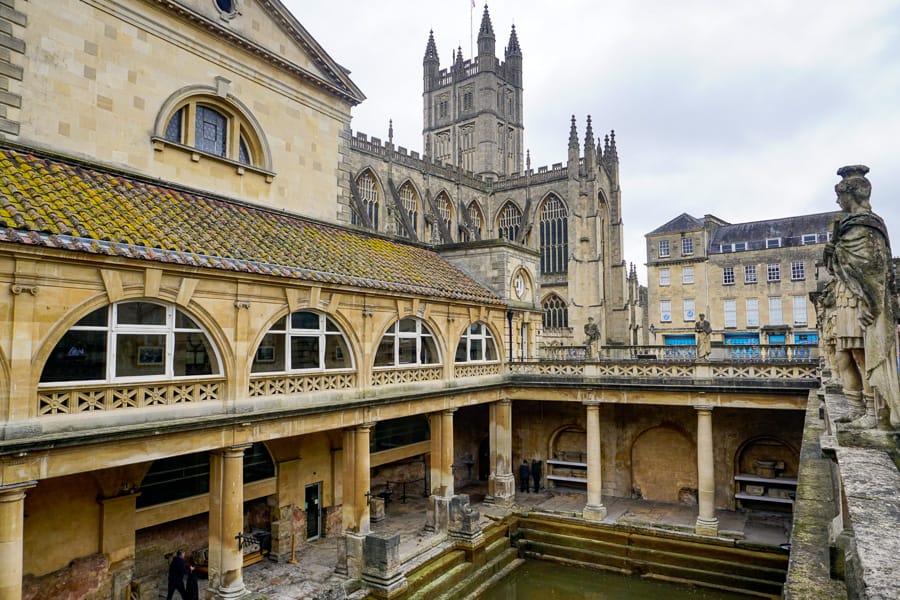
Where to stay in Bath
You’ll be spending the next two nights in Bath. As a World Heritage city, a university city and a popular tourist destination, Bath offers accommodation right across the spectrum, from backpacker stays to serious luxe. The stays below are all in the city centre and have great reviews. If you’re after onsite parking, you’ll find more options outside of the historic centre.
- Good value: The Z Hotel – great location | tiny but comfy rooms | friendly staff (we stayed here and while the room was teeny and the bathroom walls are frosted glass, which may not suit everyone, it was perfect for our stay and we loved the location)
- Mid-range: The Henry Guesthouse – centrally located | cosy & comfy | lovely staff
- Spend a bit more: Eight – restored historic house | big, beautiful rooms | close to abbey
Day 13 – Castle Combe, Lacock Abbey & Bath
Highlights: Cotswolds village of Castle Combe | Lacock Abbey | Final evening in Bath
Total driving distance: appx. 60km (37 miles)
Total driving time: appx. 1.5 hours
Overnight: Bath
You have another night Bath tonight, so you’ll have a second bite of the Bath dining scene. Today, though, we’re back in the car to explore some of the countryside highlights in this area.
Castle Combe
Stretching north of Bath is the beautiful Cotswolds National Landscape. This is quintessential English country-and-village touring, and we recently spent a wonderful few days travelling through the area. There’s so much to see across this landscape though that it really deserves a couple of days at bare minimum.
For this reason, we haven’t included the Cotswolds more broadly in this itinerary. What we have included is a taster, with a visit to a hamlet on the southern edge of the Cotswolds, Castle Combe. The bonus is that Castle Combe is one of the most photogenic of all the Cotswolds villages. It’s around 35 minutes’ drive north of Bath.
Castle Combe village, as you see it today, dates largely back to the 14th and 15th centuries, when the cloth industry took off. The village flourished until water levels in the Bybrook River, critical for powering mills, dropped to the point the industry had to move. There have been virtually no new buildings in the village since. So what you see is an authentic snapshot of a village from a time long passed.
Have a wander, taking in the pretty Cotswold stone cottages, the market square with its 14th century market cross, and historic St Andrew’s Church. The village’s two pubs, the Castle Inn and The White Hart, date back to the 12th and 14th centuries.
The Manor House, a country house-turned-hotel, sits on the site of the former Norman castle that gave the village its name.
There’s very limited street parking in and on the approach to the village. Your best bet for Castle Combe parking is in the paid Dunns Lane public car park, a 5 to 10 minute walk up the hill.

Lacock Abbey
Our next stop today is the 800 year-old Lacock Abbey. It’s a 20 minute drive from Castle Combe.
Built in the 13th century as a nunnery, Lacock Abbey became a grand country home following Henry VIIIs Dissolution of the Monasteries. It went on to be redecorated and remodelled throughout the ensuing centuries to suit ever-changing architectural and artistic tastes.
Today’s, Lacock Abbey is a National Trust site. It’s open daily till around 5pm but check the National trust website before you go. There’s an entry fee plus a car park charge.
Late afternoon and evening in Bath
Back in Bath this afternoon and evening, check out whatever you didn’t get to see and do yesterday and pick somewhere awesome for dinner. It is, after all, the last night of our road trip!

Day 14 – Return to London via Stonehenge
Highlights: Standing stones and museum of Stonehenge
Total driving distance: appx. 160km (100 miles)
Total driving time: appx. 2 hours 15 minutes, but keep an eye on traffic and factor in extra time as Greater London traffic is often seriously congested (especially the M25) and can add quite a bit of time to your journey.
It’s the final day of our epic two week south west England road trip itinerary!
Today you’re headed back to London, a 160km (100 miles) drive east of Bath. But we’ve included one more stop to break up the journey. It’s a tourist magnet, sure, but there’s a good reason for that: this is, after all, the pinnacle of ancient places to visit in south west England, if not the whole of the UK. We’re talking, of course, about Stonehenge.
Stonehenge
Stonehenge is around an hour’s drive south east of Bath. It’s open from 9.30am to 5pm daily and we recommend getting there for opening as it gets busy.
Improvement programs in recent years have changed Stonehenge dramatically since our first visit some 20 years ago and we love coming here now.
Tour the excellent visitor centre and museum and then take a walk (or the shuttle bus) out to the henge itself, where a redesign of the walkways means you can actually see and photograph the stones without a million people in the scene.
Wander back to the visitor centre through the fields and past prehistoric mounds and monuments. Today’s experience is an entirely new and enlightening perspective on this incredibly ancient place and not to be missed.
We also recommend downloading the English Heritage Stonehenge Audio Guide before you visit.
There’s a large car park at the site and you can book tickets on arrival, but you’ll save money if you buy them online ahead of time. English Heritage and National Trust (England) members can visit for free.

Time for one last classic pub lunch, if you can spare the extra hour. There are some excellent old pubs in the region around Wiltshire, like cosy 17th century pubs, The Swan at Enford and The Crown Inn at Cholderton, both around 15 minutes’ drive from Stonehenge.
Back in the car, set the GPS for Heathrow Airport, Gatwick Airport or your London base, and enjoy the remainder of the journey recapping the many, many highlights of this magical taster of England’s incredible south-west.
Planning a South West England Road Trip
Getting to London
The start and finish point for this itinerary is London Heathrow, the UK’s largest airport, and a convenient location to collect and drop off a hire car. It’s also in the west of London, so it makes a good launchpad for our journey through the south west.
You could also start this itinerary from London Gatwick, which has a huge range of car hire options as well and is south of London.
Both airports are serviced by flights from around the world. Both can also be reached by direct and regular trains from central London, which in turn can be reached by trains from all over the UK mainland and from several cities in Europe.
Best time to visit south west England
People joke about it always being grey in England. And they wouldn’t be entirely wrong. It certainly feels like it’s overcast and drizzly a lot of the time, especially in winter. But there can also be lovely dry, sunny spells.
Come expecting it to be overcast, always carry a rain jacket, and don’t let it get in the way of your day. In our experience, all the grey days just make the sunny days that much more welcome and enjoyable.
But is there a best time to visit England’s south west?
Summer – Some would say summer is best, when the chance of sun is greater and the days warmer. It’s a good time to get outdoors, go walking and visit the beaches of the south and south west coasts.
July and August are the busiest months in these areas, for both tourists and locals. Prices go up and accommodation can book out well in advance, especially in some of the coastal towns we visit on this itinerary. We don’t enjoy crowds or the hassle of trying to find parking in peak periods. So we’d personally avoid road tripping the south west in summer.
Winter – Over December to February, London and the bigger cities are still busy with tourists but it gets much quieter in the countryside and smaller villages. At this time of year, the days are shorter and it can get really chilly if you’re spending time outdoors. On the plus side, the low sunlight (when it makes an appearance) at this time of year casts everything in a beautiful golden glow.
Most importantly though, many cafes, restaurants, accommodations and historic sites close over the winter season, generally reopening around late March. We’ve travelled the south west in the wintertime and it’s beautiful, but all the closures can take a bit of the fun out of the itinerary. It’s definitely something to consider when planning your trip.
Spring and Autumn – In our opinion, the shoulder periods of Spring (March to May) and Autumn (September to November) are the best times to road trip south west England. Outside of holiday periods, it’s not quite as busy and the countryside colours are at their best: bright and vivid in spring, and warm and muted in Autumn.
Where to stay in south west England
You’ll find just about every kind of accommodation in the south west, to suit every price point. There are campgrounds, vacation rentals, apartments, B&Bs, boutique and budget chain hotels – everything.
A uniquely British accommodation experience, and one of our favourite types of stay when we travel here, is a room in an historic coaching inn or pub. It’s a wonderfully ambient experience, and often includes an epic Full English breakfast – required eating at least once on road trips in the UK (but maybe not every day like we tend to).
When we road trip, we usually stay in comfortable mid-range hotels and apartments, preferably with parking onsite or nearby. Throughout this post, we’ve included suggested budget, mid-range and higher price point accommodation options that have excellent reviews and which we’ve either stayed at ourselves, or which we would choose to stay in.
Book accommodation well ahead, particularly if you’re wanting to stay somewhere particular or you’re travelling during the summer peak period.
We mainly use Booking.com to find and book accommodation when we travel.
Driving and renting a car in England
Some key points to note if you’re coming from overseas and plan on driving in England, or anywhere in the UK:
- You need to carry a valid driving licence from your home country to drive a car in the UK. However, if your home licence is not in English, you’ll need an International Driving Permit.
- In the UK, you drive on the left side of the road and your steering wheel is on the right side of the car.
- Familiarise yourself with the road rules and signage.
- Always make sure you have appropriate travel insurance.
- If you’re renting a car, aim to do so well in advance to get the best deal and the right car for you. We use RentalCars.com and Discover Cars to find our hire cars.
If you have any questions, thoughts or updates to share about our south west England road trip itinerary, let us know in the comments below!
If you’re looking for more great road tripping itineraries and adventures, check out our Road Trips page, and our bucket list of 100 ultimate road trips around the world.

Thanks for sharing amazing information and ideas about road trips and travel in the UK.
Regards: Lux Transfers UK
Thanks Maroof, glad you found it useful.
Would like mor information on your tour. Is sounds terrific. Please send information
Hi Hedley
Thanks for your message! You might be able to find organised tours for this kind of trip by searching on TripAdvisor and similar sites. However, if you’re driving your own car or hiring a car, we hope you might find our post useful as a suggested itinerary for travelling this route independently.
All the best!
Danielle and John
The Wells Cathedral looks beautiful. I would love to explore its architecture from inside out. Another landmark that I dream of exploring is the Stonehenge. I would love to do this road trip.
Hey Rezmin, both amazing destinations and well worth a visit! Thanks for your message!